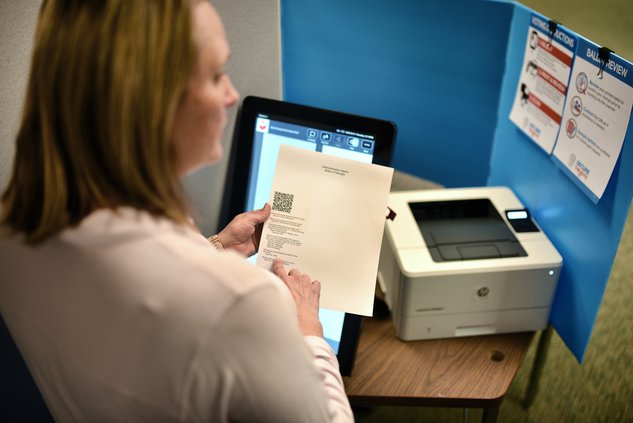Georgia’s new voting machines will be used in Hall County for the first time Monday, March 2, as early voting starts for the March 24 presidential preference primary and special election. Here's your guide to the long, busy 2020 election season.
What to expect
Checking in: When a voter arrives at the polling place, he or she will first check in with a poll worker using a touchscreen tablet called a “poll pad.” The tablet will scan the voter’s license, and the poll worker will verify the voter’s eligibility. If the voter brought another form of identification, the poll worker can check it and manually enter the voter’s information. The voter will confirm the information and sign on the poll pad.
Making selections: Then, the voter will get a special access card to insert into the voting machine, which has a large touchscreen. The voter will be able to read instructions about how to use the equipment before voting. The voter will make selections then have the opportunity to review choices before clicking “print ballot.”
Confirming: A printer at the polling station will produce a paper ballot with the voter’s choices listed for review. The ballot will be printed with the voter’s choices face-down. If the voter realizes he or she has made selections in error, the voter can raise a hand to flag down a poll worker to help start a new ballot.
Voting: The voter will bring the ballot to a table stationed by the door to feed the ballot into a scanner that drops the ballot into a locked box. Each tabulator box can hold about 2,500 ballots, and polling places will have backup boxes for when a box is filled. Magnifying glasses will also be stationed near the scanners so people can double check their ballots before casting them. The font printed on the ballots is relatively small. Voters need to make sure the ballot is put through the scanner. Ballots are not counted until they are scanned. Poll workers will be stationed by the scanners and the door to ensure votes are cast properly.
Instructions from the Secretary of State
Secure the Vote from GA SOS on Vimeo.
Help available
In the voting area of each polling place, there will be one poll worker for every three machines to help voters if they have questions.
Voters will be casting their ballots with their back to a wall or divider, and privacy screens are set up around the machines to protect privacy.
Lori Wurtz, Hall’s elections director, said she has found the system to be voter-friendly.
“It’s very comprehensive,” Wurtz said. “I think anyone can use this even if they don’t have computer experience. It’s just going to be really easy and self-explanatory.”
To test the machines, every county in Georgia held a mock election on Wednesday, Feb. 26, with volunteers going through the process and answering questions about Georgia trivia in the voting booth. Votes were tallied and sent to the Secretary of State’s Office, just like they will be on election night.
“The county officials who actually run the elections proved they have the skills and the equipment to be ready for a record turnout when Georgia launches secure paper balloting statewide,” Secretary of State Brad Raffensperger said in a statement.
The previous voting system had been in use since 2002.

